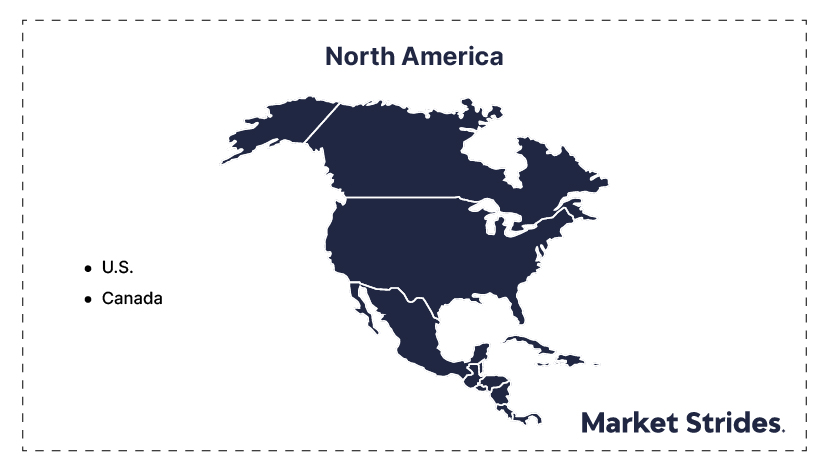The North America postmenopausal vaginal atrophy drugs market size is expected to grow at a CAGR of 6.34% during the forecast period (2025–2033). In the past few years, an increased emphasis on improving women's health and overall well-being is driving demand for effective treatments that enhance sexual health, comfort, and daily life quality for postmenopausal women. This is estimated to drive the North America postmenopausal vaginal atrophy drugs market.
Postmenopausal Vaginal Atrophy (PVA) drugs are medications used to treat vaginal atrophy, a condition common in postmenopausal women due to decreased estrogen levels. Symptoms include vaginal dryness, irritation, painful intercourse, and recurrent urinary tract infections. Treatment options include estrogen-based therapies (creams, tablets, rings), selective estrogen receptor modulators (SERMs) like ospemifene, and non-hormonal options such as vaginal moisturizers and dehydroepiandrosterone (DHEA) suppositories. These drugs help restore vaginal tissue elasticity, improve lubrication, and alleviate discomfort.
The increasing postmenopausal population in this region is a significant driver for the North America postmenopausal vaginal atrophy (PVA) drugs market. As life expectancy rises, more women are experiencing menopause-related complications, including vaginal atrophy, which requires effective treatment. Hormonal and non-hormonal therapies are in high demand to manage symptoms and improve quality of life.
This growing patient pool has driven the adoption of therapies such as Vagifem (Novo Nordisk) and Imvexxy (TherapeuticsMD), supporting the North American postmenopausal vaginal atrophy (PVA) drugs market expansion.
Hormonal therapies, particularly estrogen-based treatments, are associated with potential health risks, including an increased likelihood of breast cancer, cardiovascular diseases, and blood clots. These safety concerns limit their widespread adoption, particularly among women with a history of hormone-sensitive cancers or heart conditions.
Additionally, non-hormonal treatments may have side effects such as irritation, allergic reactions, or gastrointestinal issues, further impacting patient adherence. Regulatory scrutiny over the long-term effects of these treatments also poses challenges for market share. As a result, many patients and healthcare providers remain cautious, leading to a preference for alternative therapies or non-pharmacological management strategies.
The growing preference for non-hormonal therapies in treating postmenopausal vaginal atrophy (PVA) is opening new opportunities in the North American market. Women who cannot use estrogen-based treatments due to cancer risks or cardiovascular concerns are increasingly turning to alternative solutions. Pharmaceutical companies are investing in novel non-hormonal options to meet this demand.
As these innovative treatments provide effective symptom relief while addressing safety concerns, they present a significant market opportunity for expansion in North America.
| ATTRIBUTES | DETAILS |
|---|---|
| Study Period | 2021-2033 |
| Historical Year | 2021-2024 |
| Forecast Period | 2025-2033 |
| By Drug Type |
|
| By Route of Administration |
|
| By Distribution Channel |
|
| Regional Insights |
|
Estrogen-based therapy is the most widely used treatment for postmenopausal vaginal atrophy in North America. It includes topical creams, vaginal tablets, rings, and systemic hormone replacement therapy (HRT). These therapies help restore vaginal tissue elasticity, lubrication, and pH balance, effectively reducing symptoms like dryness, itching, and discomfort. However, concerns over long-term estrogen use, including risks of breast cancer and cardiovascular diseases, have led to cautious adoption. Despite these concerns, advancements in low-dose formulations and alternative delivery methods continue to drive demand for estrogen-based therapies in the region.
Oral therapies, including estrogen and non-hormonal medications, offer a convenient treatment option for postmenopausal vaginal atrophy (PVA) drugs. These medications work systemically to alleviate symptoms such as vaginal dryness, irritation, and pain during intercourse. While effective, oral estrogen carries risks of systemic side effects, including blood clots and increased cancer risk, leading some patients to seek alternative options. Non-hormonal oral drugs, such as selective estrogen receptor modulators (SERMs), provide a safer alternative. The growing preference for personalized medicine and improved formulations continues to enhance the adoption of oral treatments in North America.
Hospital pharmacies play a crucial role in the distribution of postmenopausal vaginal atrophy drugs, particularly for prescription-based treatments. They provide access to both estrogen and non-hormonal therapies under the guidance of healthcare professionals, ensuring appropriate drug selection and dosage. Hospital settings also facilitate patient education, improving treatment adherence and outcomes. Moreover, the presence of specialized gynecological care in hospitals enhances the demand for advanced and personalized therapies. With increasing hospital visits for menopause-related concerns, the hospital pharmacy segment remains a key contributor to market growth in North America.
The North America postmenopausal vaginal atrophy (PVA) drugs market is growing at a significant rate due to its well-established healthcare infrastructure, high awareness levels, and the increasing prevalence of postmenopausal women.
Additionally, the growing acceptance and discussion of menopausal health issues, influenced by public figures, have contributed to a more open dialogue and increased treatment-seeking behavior among women. For instance, discussions around women's health issues, including menopause, sparked by public figures like former U.S. First Lady Michelle Obama, have driven interest in women's health drugs, leading to a significant revenue surge for companies in this sector.
Moreover, the region has witnessed advancements in both hormonal and non-hormonal treatments. For instance, in 2022, the FDA approved Imvexxy, a low-dose estradiol vaginal insert developed by TherapeuticsMD, which offers localized estrogen therapy with minimal systemic absorption, addressing safety concerns linked to traditional hormone replacement therapy (HRT).
Moreover, pharmaceutical companies are increasing investments in women’s health, which is shaping the market. For instance, Organon, a spin-off of Merck & Co., has committed to advancing women’s health treatments. Since its launch in 2021, Organon has invested in strategic acquisitions and collaborations, such as its 2023 partnership with Daré Bioscience to develop Ovaprene, a hormone-free contraceptive, reflecting a broader investment trend in non-hormonal women’s health solutions.
Telemedicine has also emerged as a major enabler, with platforms like Hers & Evernow offering prescription-based online consultations, improving access to treatments for underserved populations. Despite high treatment costs and concerns over hormone therapy risks, North America's focus on research, regulatory approvals, and digital health adoption positions it as a key market for postmenopausal vaginal atrophy (PVA) drug development.

Request Table of Contents (TOC), Please Fill below form



